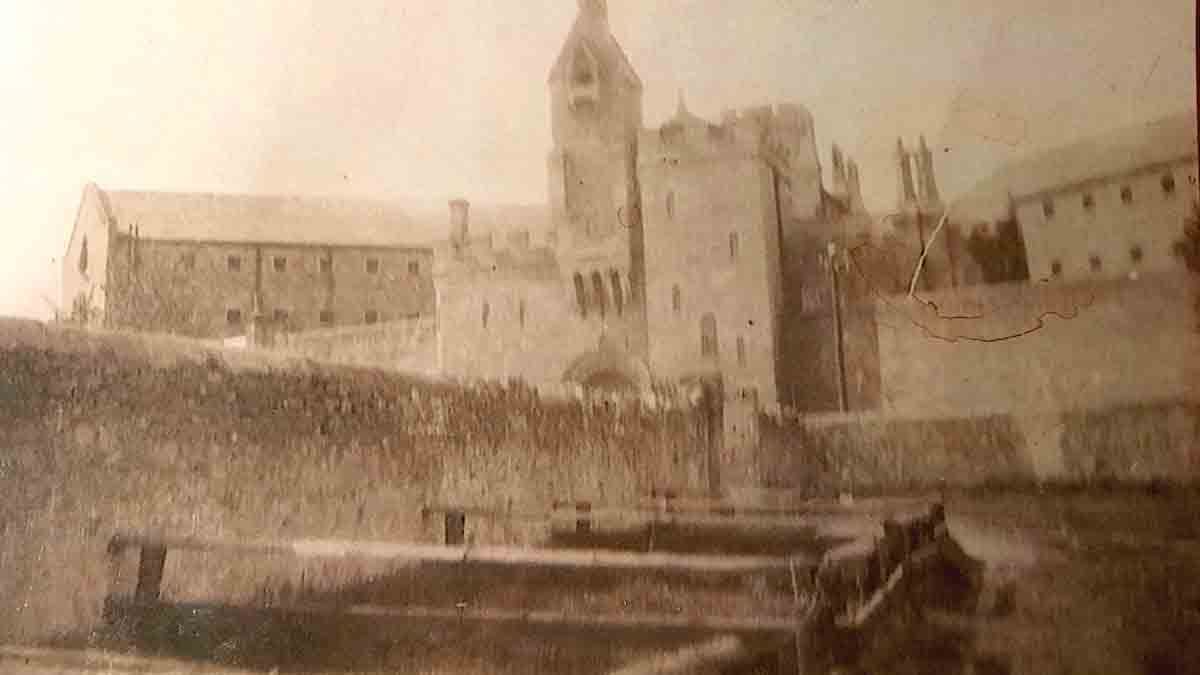Members of The Saturday Walkers group gathered on the green patch of ground at the intersection of St Rioch Street and Saint Francis Terrace
The significance of a housing estate named Fr. Delahunty Terrace, a mere one hundred yards away becomes obvious.
It was a cold Saturday morning.
Scarves, woolly hats and gloves were the call of the day to fight the elements.
Almost one hundred years ago, at the same area, forty seven men also gathered.
Not for them gloves, hats or overcoats.
Some were shirtless, covered in mud, most with their boots hanging around their necks by their shoelaces.
They emerged one by one from a freshly built tunnel about three feet in diameter.
This would become known as The Kilkenny Jail escape.
The Most audacious escape from an Irish prison.
Insightful talk
Almost a hundred years to the day later, Kilkenny walker’s group member, Jimmy Neary gave a very insightful talk on the daring escape.
The gathering was made all the more special as some family members of the escapees were in attendance.
These included sisters Carmel Lenehan and Geraldine Bransfield, daughters of Jim Pollock, one of the men who escaped
Jim and Dan Lenehan, grandsons of Jim Pollock attended with their mother Carmel.
Also in attendance was Noel Delahunty, nephew of Fr Delahunty and brothers Noel and Vinny Delahunty, grandnephews of Fr Pat.
Expert Tunnel diggers
The Kilkenny People, commenting on the escape of IRA prisoners from the Kilkenny Gaol on 22nd November 1921, advised on the possibility of a future Channel Tunnel being built, that the contractor should get in touch with Larry Condon of Fermoy and Martin Kealy of Kilkenny and their comrades.
‘What they do not know about constructing tunnels is not worth knowing, and they will refuse to be hampered by consideration of an eight hour day.’
Preparation key to success of daring escape
Kilkenny historian, Jim Maher has described in great detail the preparations for and the execution of a daring escape by prisoners, two of whom were under death sentences.
They were Edward Punch and Timothy Murphy of Limerick.
The fact that the Truce was signed in July was no guarantee of their lives being saved.
It could break down at any time. The Treaty when signed in December resulted in the fall of the British Government and a Civil War in Ireland.
A friendly warder named Power was privy to the prisoner’s plan of escape.
When he was on duty a considerable amount of tunnelling was done. A cellar existed below the recreation room.
The prisoners cut a manhole through the floor to gain access and of course covered the hole with timber. From the cellar they managed to get to the soft earth and began tunnelling. The work was done mostly at night. Knives and pointed fire irons were used to loosen the earth. The soil was then removed in sacks made of the prisoners’ blankets.
8 Tons of earth taken from tunnel
Later on the loose earth was taken from the tunnel in a large flat pan attached to a rope. About 8 tons of earth was removed in the process. It was deposited in the disused cellar. The tunnel was 50 yards in length and almost 6 feet deep under the ground. It exited alongside the foundation of the outer wall. The tunnel had to have props or it would collapse. Bed boards fulfilled this function. The exit to the tunnel was about 3 feet wide and came up in St Rioch’s Street.
When completed it was decided the escape should happen on Warden Power’s watch. To cover his collusion in the matter he was trussed and gagged and left in acell.
Larry Condon, although leader of the escape party offered first position to the patriot priest Fr Delahunty.
First escape position offered to Fr Pat
Having been offered to be the first to escape, Fr Delahunty declined, saying he would only go after the men who were sentenced to death and the lifers were out.
Larry Condon entered the tunnel at 6.40 pm on 22 November and successfully negotiated the tunnel. He remained outside the gaol and helped each succeeding escapee up out of the hole. They were all muddied and wearing very little clothing – their boots draped by their laces round their neck.
Retreat to prison following collapse
Maurice Walsh of Limerick was last into the tunnel and unfortunately it collapsed ahead of him causing him to retreat into the prison. When he got back he was faced with armed soldiers sounding the alarm. Warden Power had been discovered.
In Rioch Street two locals helped the escapees. They were Paddy Donoghue and Matty Power – both either current or future Kilkenny hurling stars.
Power’s daughter later spoke of what she learned of the escape on Sunday Miscellany. Aly Luttrell of Garryricken and Cumann Na mBan had previously been thrown a letter tied around a stone from the prison giving day and time of the proposed escape. Dunamaggin IRA arranged six ponies and traps to transport escapees. They were present on time.
The escapees were taken South muddied but unbowed.
Fógra: Carmel Lenehan and Geraldine Bransfield laid a wreath on the site to mark the occasion.
Fógra Eile: As the talk finished, informal plans were being mooted about a monument being erected at the site to remember the men.
SOURCES: Historian Jim Maher, St Rioch’s book for photo of Jail, Kilkenny Walkers group, Pat Walsh Memorial, jbs photography.


























